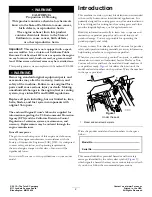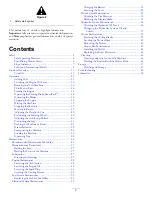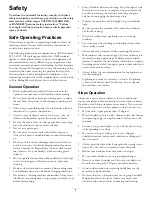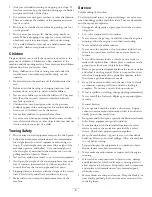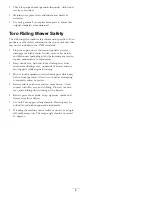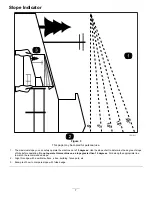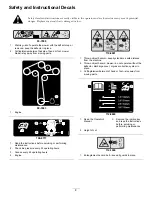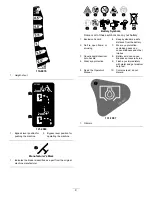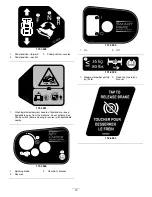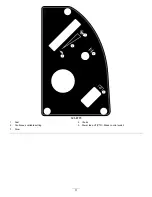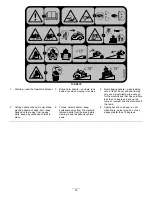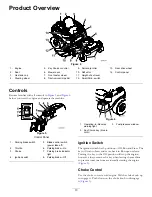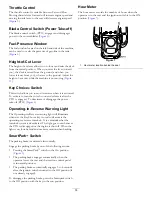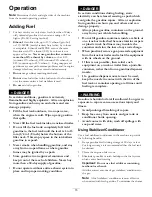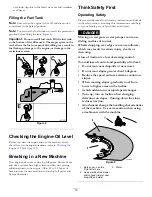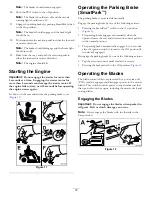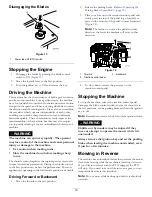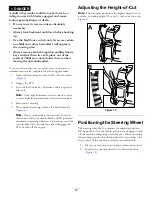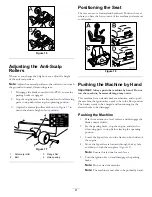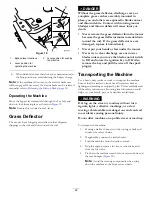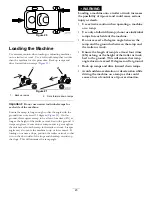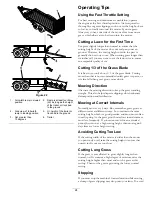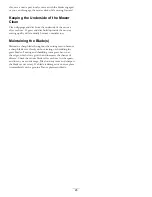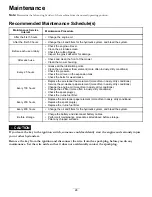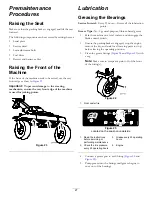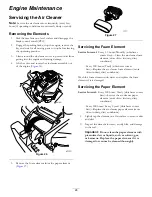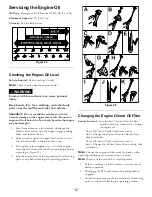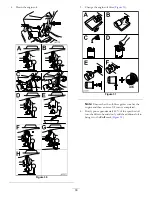
Operation
Note:
Determine the left and right sides of the machine
from the normal operating position.
Adding Fuel
•
For best results, use only clean, fresh (less than 30 days
old), unleaded gasoline with an octane rating of 87 or
higher ((R+M)/2 rating method).
•
Ethanol
: Gasoline with up to 10% ethanol (gasohol)
or 15% MTBE (methyl tertiary butyl ether) by volume
is acceptable. Ethanol and MTBE are not the same.
Gasoline with 15% ethanol (E15) by volume is not
approved for use.
Never use gasoline that contains
more than 10% ethanol by volume
, such as E15
(contains 15% ethanol), E20 (contains 20% ethanol), or
E85 (contains up to 85% ethanol ). Using unapproved
gasoline may cause performance problems and/or engine
damage which may not be covered under warranty.
•
Do not
use gasoline containing methanol.
•
Do not
store fuel either in the fuel tank or fuel containers
over the winter unless a fuel stabilizer is used.
•
Do not
add oil to gasoline.
DANGER
In certain conditions, gasoline is extremely
flammable and highly explosive. A fire or explosion
from gasoline can burn you and others and can
damage property.
•
Fill the fuel tank outdoors, in an open area,
when the engine is cold. Wipe up any gasoline
that spills.
•
Never fill the fuel tank inside an enclosed trailer.
•
Do not fill the fuel tank completely full. Add
gasoline to the fuel tank until the level is 6 to 13
mm (1/4 to 1/2 inch) below the bottom of the
filler neck. This empty space in the tank allows
gasoline to expand.
•
Never smoke when handling gasoline, and stay
away from an open flame or where gasoline
fumes may be ignited by a spark.
•
Store gasoline in an approved container and
keep it out of the reach of children. Never buy
more than a 30-day supply of gasoline.
•
Do not operate without entire exhaust system in
place and in proper working condition.
DANGER
In certain conditions during fueling, static
electricity can be released causing a spark which
can ignite the gasoline vapors. A fire or explosion
from gasoline can burn you and others and can
damage property.
•
Always place gasoline containers on the ground
away from your vehicle before filling.
•
Do not fill gasoline containers inside a vehicle or
on a truck or trailer bed because interior carpets
or plastic truck bed liners may insulate the
container and slow the loss of any static charge.
•
When practical, remove gas-powered equipment
from the truck or trailer and refuel the equipment
with its wheels on the ground.
•
If this is not possible, then refuel such
equipment on a truck or trailer from a portable
container, rather than from a gasoline dispenser
nozzle.
•
If a gasoline dispenser nozzle must be used,
keep the nozzle in contact with the rim of the
fuel tank or container opening at all times until
fueling is complete.
WARNING
Gasoline is harmful or fatal if swallowed. Long-term
exposure to vapors can cause serious injury and
illness.
•
Avoid prolonged breathing of vapors.
•
Keep face away from nozzle and gas tank or
conditioner bottle opening.
•
Avoid contact with skin; wash off spillage with
soap and water.
Using Stabilizer/Conditioner
Use a fuel stabilizer/conditioner in the machine to provide
the following benefits:
•
Keeps gasoline fresh during storage of 90 days or less.
For longer storage it is recommended that the fuel tank
be drained.
•
Cleans the engine while it runs
•
Eliminates gum-like varnish buildup in the fuel system,
which causes hard starting
Important:
Do not use fuel additives containing
methanol or ethanol.
Add the correct amount of gas stabilizer/conditioner to
the gas.
Note:
A fuel stabilizer/conditioner is most effective
when mixed with fresh gasoline. To minimize the chance
15
Summary of Contents for TimeCutter SWX 5050
Page 50: ...Schematics Electrical Diagram Rev A 50 ...
Page 51: ...Notes 51 ...


